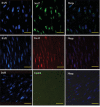Differentiation of Human Wharton's Jelly Mesenchymal Stem Cells into SOX17 Expressing Cells Using a Wnt/ß-catenin Pathway Agonist on Polylactic Acid/Chitosan Nanocomposite Scaffold
- PMID: 35279960
- PMCID: PMC8918270
- DOI: 10.22074/cellj.2022.7622
Differentiation of Human Wharton's Jelly Mesenchymal Stem Cells into SOX17 Expressing Cells Using a Wnt/ß-catenin Pathway Agonist on Polylactic Acid/Chitosan Nanocomposite Scaffold
Abstract
Objective: The β-catenin signaling pathway promises the potential for differentiation of stem cells into definitive endoderm (DE) cells as precursors of beta cells. Therefore, it can be considered as an inducer for cell replacement therapies in diabetes. The main goal of this research is to successfully culture and induce differentiation of human Wharton's jelly mesenchymal stem cells (hWJMSCs) into Sox17-expressing cells using a Wnt/β-catenin pathway agonist (SKL2001) plus nanoparticles on a polylactic acid/chitosan (PLA/Cs) nanocomposite scaffold.
Materials and methods: In this experimental study, the nanocomposite was prepared through an electrospinning method and hWJMSCs were isolated through an explant technique. The morphology and the cell viability were evaluated by scanning electron microscopy (SEM) and 3-(4, 5- Dimethylthiazol-2)-2, 5-diphenyltetrazolium bromide (MTT) assay. Here, we present two differentiation protocols: the first one is induction with SKL2001; and the second one is with a combination of SKL2001 and zinc oxide nanoparticles (nZnO). Real-time quantitative reverse transcription (QRT-PCR) and immunocytochemistry analysis are carried out to examine the expression of specific markers in the differentiated cells.
Results: The nanocomposite had appropriate biocompatibility for cell adhesion and growth. While the hWJMSCs cultured on the PLA/Cs scaffolds differentiated into DE cells in the presence of SKL2001, introducing nZnO to their environment increased the differentiation process. Analyses of DE-specific markers including SOX17, FOXA2, and gooscoid (GSC) genes in mRNA level, indicated significantly high levels of expression in the SKL2001/nZnO group, followed by SKL2001 group compared to the control.
Conclusion: Our results show the beneficial effects of the Wnt/β-catenin pathway agonist in three-dimensional (3D) cultures in cell replacement therapy for diabetes.
Keywords: Differentiation; Nanoparticles; Tissue Engineering; Wharton’s Jelly; Wnt/β-Catenin Pathway.
Copyright© by Royan Institute. All rights reserved.
Conflict of interest statement
There is no conflict of interest in this study.
Figures





References
-
- Cabezas J, Rojas D, Navarrete F, Ortiz R, Rivera G, Saravia F, et al. Equine mesenchymal stem cells derived from endometrial or adipose tissue share significant biological properties, but have distinctive pattern of surface markers and migration. Theriogenology. 2018;106:93–102. - PubMed
-
- Jurewicz E, Wyroba E, Filipek A. Tubulin-dependent secretion of S100A6 and cellular signaling pathways activated by S100A6-integrin β1 interaction. Cell Signal. 2018;42:21–29. - PubMed
LinkOut - more resources
Full Text Sources
Research Materials
